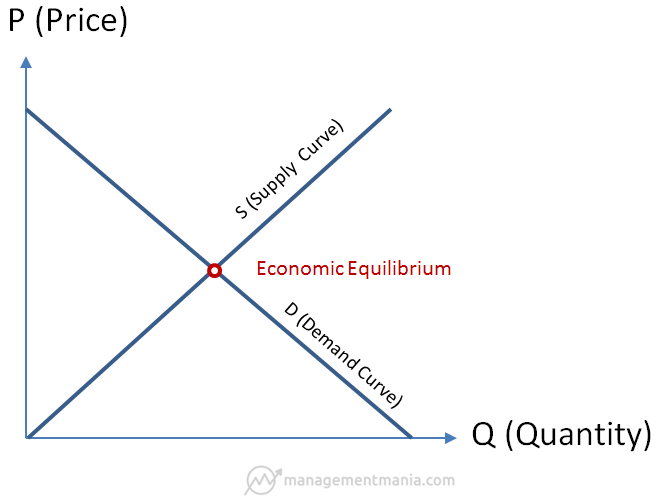What is Equilibrium?
- Market equilibrium occurs where the demand and supply curves meet on a graph.
- This leads to price equilibrium and quantity equilibrium.
- This means that everything that is being produced is being consumed.
- This means that there are no shortages (excess demand) or surplus (excess supply).

Price at the Market Equilibrium
- The price at the market equilibrium is called the market clearing price, as the market is clearing everything that is being produced.
- The equilibrium price doesn't mean that everyone is buying at that price, it just means that everything is being sold at that price.
- For a variety of goods, it only represents the average price.
- Equilibrium is constantly changing in reality.
- Disequilibrium occurs until a new equilibrium is found.
Examples
- If price is increased, then demand goes down, but supply goes up, but demand goes down.
- Thus if you keep a high price then you will have a large amount of excess supply.
- If you decrease your prices, for example to gain market share, then there will be a very large demand compared to the supply.
- This leads to lots of unmet demand.
- Over time this forces the market to correct itself.
Effects of Outside Disturbances
- Outside factors cause the supply and/or demand curves to move, changing the equilibrium.
- Equilibrium changes when either demand or supply changes due to one of the non-price determinants that shift either curve.
- A change in price does not affect the equilibrium.
Example
- If people's income increases, then demand increases, causing the demand curve to shift to the right.
- This means that the equilibrium is now at a higher price. Firms will thus change their prices to meet the new market clearing price.
- Increased demand has caused an increased price, causing inflation.
The Role of Price Mechanism
- The forces of demand and supply are otherwise known as a price mechanism.
- It will move markets to equilibrium.
- There can be some regulations that mandate a minimum or maximum price level. Set by the government to pay fair wages for example.
- Otherwise the market will always move itself back into the equilibrium.
- The price mechanism has a very important role in economics.
- The price mechanism dictates resource allocation.
- If demand shifts to one direction, producers will allocate limited resources towards that.
- Producers will allocate less resources to substitute products which have comparatively less demand.
- This is assuming that producers are profit maximizers and there is no central planning agency.
Example
- Government interference such as rent control can have an affect on supply and demand. If the government sets a maximum price for rent, this can lead to an excess in demand.
- The supply for rented flats would go down, however when the cheaper price would cause increased demand. Thus leading to excess demand.
Invisible Hand
Example
- If the demand for wholegrain bread goes up, then producers will allocate some of the wheat used for white bread to make wholegrain bread instead.
- This is called the "Invisible hand", as suppliers will produce the goods at prices that fulfill the needs and wants of consumers, even if doing so for their own gain.
- Due to regulations such as protecting ethics and the environment, the invisible hand is not usually allowed to act unsupervised.
- As while the invisible hand usually acts for good, it can also have negative effects. Such as an increase in drug addictions increasing the supply for them as the demand for drugs increases.